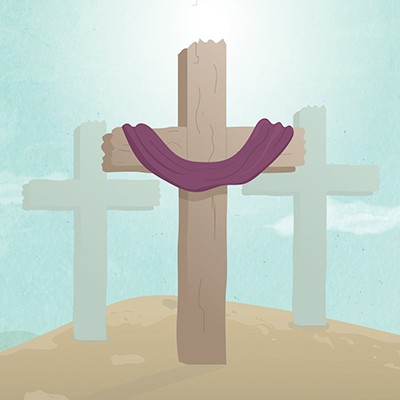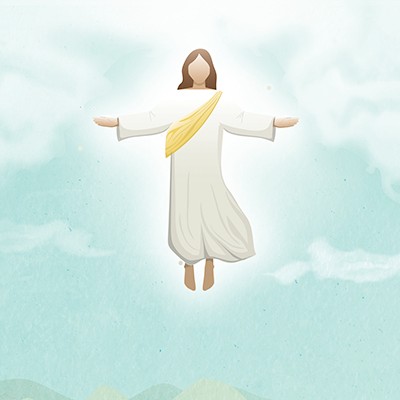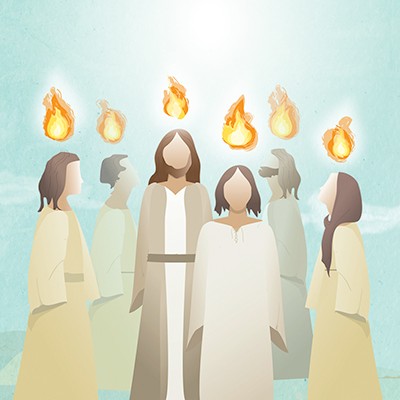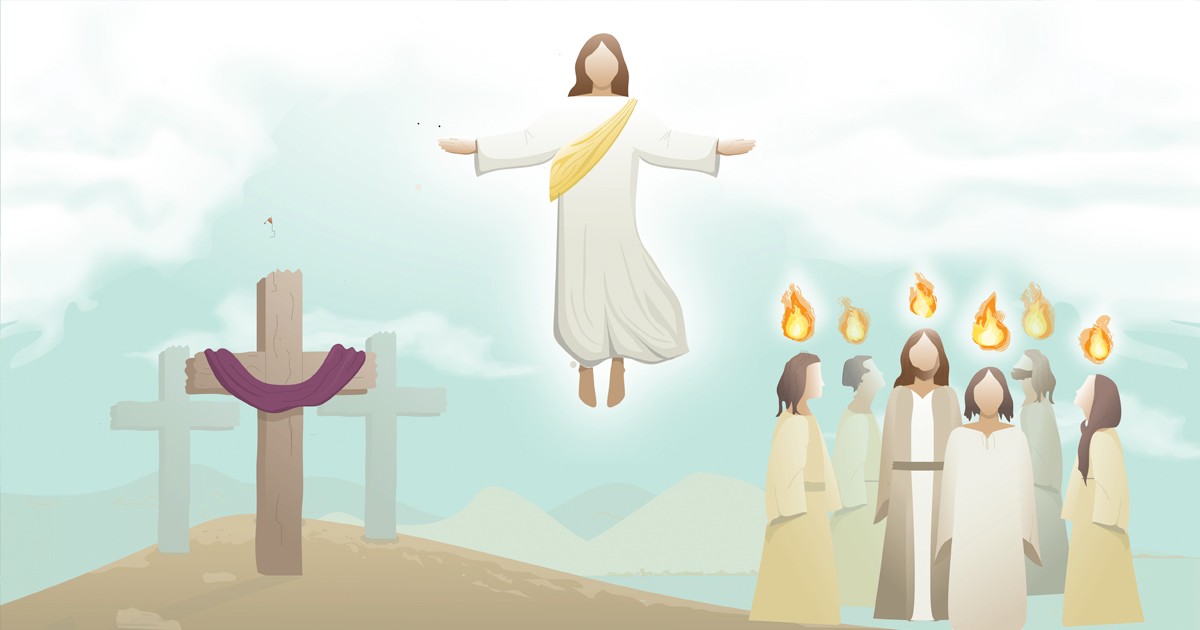We all know that Easter is not about chocolate, bunnies or other commercial trappings. The focus for Christians is on Jesus Christ. But do we appreciate how the Easter season accentuates the Trinity?
Jesus’ Resurrection, Ascension and the outpouring of the Holy Spirit upon his followers are premises of the New Testament. Even when the events themselves are not narrated directly, they are essential to each book’s message. In other words, the meaning and relevance of the entire New Testament are predicated upon Easter and Pentecost.
In 2024, the Easter season begins on Sunday, March 31, Resurrection of the Lord, and continues through Sunday, May 19, Day of Pentecost. Appropriately, the church observes Ascension of the Lord during the Easter season, 10 days before Pentecost. Thus, the Easter season encompasses three major events from the New Testament narratives—Jesus’ Resurrection, Ascension and Pentecost. Let’s consider the background of the early Christians’ Easter faith.
Resurrection in First-Century Jewish Thought
In The Resurrection of the Son of God, New Testament scholar N.T. Wright examines speculation about the afterlife in ancient Egypt, Mesopotamia, Greece and elsewhere, and discerns that none of Israel’s neighbours believed in bodily resurrection. Not all Jews believed either (see Acts 23:8). Yet, an influential group of devout Jews known as Pharisees did. Wright explains how resurrection faith emerged steadily among Jews until it became a vivid hope in the first century.
The reasoning went something like this: after centuries of corruption, invasion and occupation by foreign nations, ancient Israelites had lost their unity, selfdetermination, land and hope. Prophets, such as Amos and Jeremiah, explained that their sin and rebellion against God led to these consequences. Empires, such as Assyria and Babylon, in devastating and displacing Israel and Judah, did the Lord’s bidding. Israelites in general (see 2 Kings 17) and Jews in particular (see 2 Kings 23:31-25:21) were humiliated and exiled.
Many righteous persons died violently, including prophets who tried to steer people aright. Innocent victims saw no justice. How could a just God not avenge their blood? How could righteousness be rewarded with violence? If death and exile are the end, then God’s purposes are thwarted, and life is hopeless.
God had called Israel to be distinct, to bless the nations, to exemplify God’s righteous character, to be holy as God is holy. As God’s servant, they were to shed light upon the nations (see Isaiah 42:1-13), but they lost their freedom to fulfil God’s call to be a beacon of justice and peace (see Isaiah 42:14-25). They were as hopeless as a valley of dry bones (see Ezekiel 37:1-14). Only a radical reconstitution could enable them to become what they were meant to be. The Lord asked Ezekiel, “Can these bones live?” (Ezekiel 37:3). On a human level, the answer is emphatically No! But, with God, the answer is Yes!
Thus, Jewish hope in resurrection arose from their belief in the just character, unfailing love and limitless power of God and in the prophetic promise that God would forgive and restore a repentant nation. Those righteous dead would live again to see a world of peace where God had wiped away every tear and expelled every evildoer (see Isaiah 25:6-9; Revelation 7:9- 17; 21:1-8). The nation would finally fulfil its God-given destiny to exemplify justice and peace. A decimated people would be fully healed, reconciled and energized.
Pharisaic Jews of Jesus’ day believed that widespread repentance and global renewal of the Israelite diaspora would lead to divine forgiveness and gathering of the exiles. All at once, God would intervene in history, restore Israel and reign in peace and justice (hence, kingdom of God, for example, in Mark 1:15).
Jews saw John the Baptist’s movement as a precursor to the resurrection (see Mark 1:4-5). Martha grieved her righteous brother’s death because the resurrection seemed far away (see John 11:17-27). Scribes reacted when Jesus pronounced forgiveness because, to them, the paralytic’s condition signified that God had not forgiven nor had adequate repentance been achieved (see Mark 2:1-12). Pharisees reacted when Jesus’ disciples plucked grain on the Sabbath (see Luke 6:1-5), because how could Israel expect God’s forgiveness and resurrection if Jews were casual about God’s dictates and presumptuous about God’s grace?
 Jesus’ Resurrection
Jesus’ Resurrection
That Jesus would inaugurate God’s reign in the ambiguous present (e.g., by healing, exorcizing evil spirits and proclaiming the gospel) was bewildering. That God would forgive a people who had not perfectly repented was disconcerting. That the resurrection of one—representative of the nation, of humanity and of each individual person—would precede the resurrection of all was shocking. The New Testament presents the Resurrection of Jesus as a staggering, yet palpable, reality. The authors use Scripture, reason, tradition and experience to explain how God’s will could unfold in this surprising way. The church has spent centuries exploring the meaning of it all.
The early church needed no proof of the Resurrection. It was an unavoidable reality that affected everything. Paul and the other apostles used the resources of their ancestral faith (e.g., the Old Testament and Jewish modes of exegesis) to explain the significance of Jesus’ Resurrection and its implications for their lives. Every Easter season, the church returns to this matter because we continue to live in a Resurrection age.
 Jesus’ Ascension
Jesus’ Ascension
Just as Jesus walked the earth in his resurrected body for 40 days, the first 40 days of Easter focus on his appearances before the Ascension. The Ascension is, in a sense, an extension of Jesus’ Resurrection because his resurrected body could not be contained by the limitations of earth. The incarnate Son of God was no longer bound by the constraints of time and space as he had been prior to his Resurrection.
In Christian doctrine, the Exaltation of Christ is the metaphorical upward movement of Jesus after “he descended to the dead,” as declared in the Apostles’ Creed. Christ’s exaltation includes his Resurrection, Ascension and Session—the doctrine that the exalted Lord Jesus Christ sits (or stands, see Acts 7:55-56) “at the right hand of the majesty on high” (Hebrews 1:3 NRSVUE).
Timothy Tennent, president of Asbury Theological Seminary in Kentucky, describes the Ascension of Christ this way: “Jesus did not just ascend from here to there.… he ascended from here to everywhere.” Whenever the New Testament mentions Jesus’ current location, it assumes the Ascension, even when it does not narrate it. Jesus is at the right hand of the omnipresent God.
 The Season After Pentecost
The Season After Pentecost
The final day of the Easter season is Pentecost, and how fitting! Jesus suggested that his Ascension was necessary for the outpouring of the Holy Spirit (see John 16:7-11). Many churches refer to the final season of the Christian calendar as “ordinary time,” but we must realize that “ordinary time,” for Christians, is extraordinary because of the outpouring and infilling of the Holy Spirit. Some churches refer to this “ordinary time” as the Season After Pentecost. I prefer that label, because it is a much-needed reminder that the Holy Spirit, poured out by our exalted Lord Jesus Christ, constitutes our new life in him and actuates the realities of God’s reign in the world (e.g., healing, exorcizing evil spirits, proclaiming the gospel, conviction, righteousness). The Season After Pentecost could label the entire church age were it not that God’s people sometimes forget their inheritance (see Ephesians 1:13-14).
The Easter season and the Season After Pentecost exemplify the trinitarian nature of the Christian faith. Never is the Father or the Spirit without the Son, nor the Son or the Father without the Spirit, and so on. I pray that we would, with the whole church, encounter the risen Lord during the season of Easter, recognize the exalted Lord during Ascension and be filled with the life-giving Spirit of God throughout the Season After Pentecost.
This is the final article in our series on the seasons that shape the Christian year.
Dr. Isaiah Allen is assistant professor of religion at Booth University College in Winnipeg.
Illustration: Emily Pedlar
This story is from:










Dear Dr. Allen, thank you very much for this information and what the Easter season is all about. I’ve forwarded your article on to our weekly bible study group as a helpful resource as we go through the lectionary readings for the Easter season.
Christ is risen! He is risen, indeed!